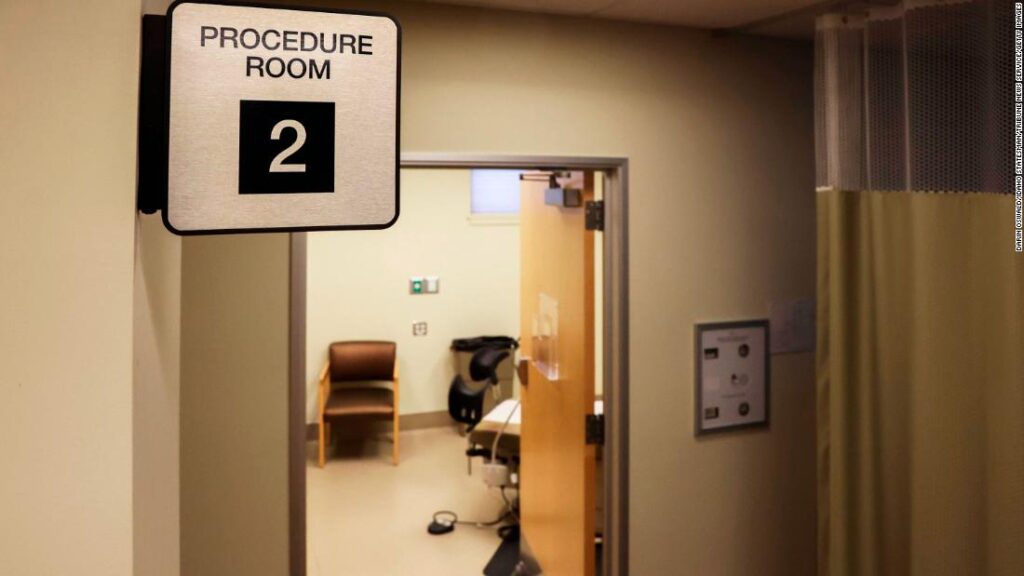
Oklahoma had become familiar with picking up after its neighbors since Texas’ Senate Bill 8 was enacted, effectively outlawing abortions past six weeks of pregnancy. Now, Oklahomans may lose their own access to abortion, causing a ripple effect for residents of neighboring states who have relied heavily on the state for abortion care.
“Overall, we saw about a 2,500% increase in patients coming to [Oklahoma’s] health centers from Texas,” said Emily Wales, interim president and CEO of Planned Parenthood Great Plains, which serves Arkansas, Kansas, Missouri and Oklahoma.
Oklahoma has only four abortion centers. Since September, when Texas’ ban was passed, those centers have seen several thousand more people from out of state. It’s resulted in longer wait times for patients seeking abortions, more hours for physicians to meet demand and increased staffing to ensure coverage.
“You can’t really be prepared,” Wales said, as the need for abortion care in Oklahoma skyrocketed almost overnight after Texas’ law went into effect.
To meet that demand, Oklahoma allowed “fly-in” physicians, or providers from other states who came to offer care for people flooding from Texas.
But Oklahoma’s abortion providers not only found themselves facing the sheer rise in patient numbers, they struggled with the unique emotional burdens that came with them.
“So many patients were coming with really high emotional needs,” Wales said. “It’s already really challenging because of state restrictions, but you add on to that, potentially, a trip overnight, finding a place to keep your kids while you are seeking care in another state and just feeling like your actions are criminalized in your home state. That was a level of intense support needs that our team has really struggled to fill.”
Anticipating the fallout from her own state’s restrictions, Wales said that it leaves even fewer options for a safe abortion in that part of the country.
“When you take out another state that’s been a huge provider of services for the region, the system is going to break. It’s not a question of whether that will happen, it’s just when,” Wales said.
She said Planned Parenthood plans to try to block the measure in court before it can come into effect.
“The fact that the same nightmare we’ve been living — with our Texas patients — is now going to happen in Oklahoma is heartbreaking for us on the provider level,” Wales said. People in Oklahoma may have to travel to Kansas, New Mexico or Colorado to get abortions.
“Bans do not eliminate the need for abortion care; they just make it a lot less safe,” she said.
Crossing state lines
Oklahoma’s abortion providers aren’t alone. Several states across the country have found themselves turning into potential safety nets for abortion care as their neighbors move to limit access.
For several months before Republican Idaho Gov. Brad Little signed his state’s version of Texas’ notoriously restrictive abortion law, abortion providers just across state lines in Washington and Oregon have been preparing for the consequences.
“We have been tracking and watching [this bill] for the past six months, once Texas passed and we began to understand how many states were going to be lined up to do the same thing,” said Anne Udall, president and CEO of Planned Parenthood Columbia Willamette, the branch overseeing seven clinics in Oregon and Southwest Washington.
“We knew this was coming. … We were getting ready for it, and we continue to get ready for it, because it will impact Oregon,” Udall said.
“There’s been a decrease of 60% of abortions in Texas since the law was passed in September, and I’m sure that’s going to happen to Idaho, as well,” said Dr. Mark Nichols, professor of obstetrics and gynecology at Oregon Health and Science University.
According to the Idaho Department of Health and Welfare, nearly 70% of abortions there take place after six weeks. That accounts for over 1,000 people a year who would no longer have access to an abortion in Idaho.
The easternmost abortion clinic in Oregon is in the city of Bend, about 300 miles from Boise — how far most people would have to travel to get an abortion if Idaho’s bill were to go into effect.
In preparation, Planned Parenthood is ensuring that all of its clinics are fully staffed. In states like Oregon and Washington, non-physician health care providers, such as nurse practitioners and midwives, can provide abortions, which helps support the provider base to meet increasing needs.
Idaho’s law would affect access to abortion not only for Idahoans but for Oregonians.
According to Dr. Erin Berry, Washington medical director and director of clinical research at Planned Parenthood Great Northwest, Hawaii, Alaska, Kentucky, the closest clinic for some people seeking abortions in eastern Oregon is in Idaho. Idaho also serves people from Nevada and Montana, said Berry, an ob/gyn and abortion provider in Idaho and Washington.
Anticipating the ramifications of Idaho’s abortion bill, the Oregon State Legislature passed House Bill 5202, which includes a $15 million allocation for the state’s Reproductive Equity Fund.
The money “will provide meaningful and immediate support to patients, health providers and community advocates to prepare for Idaho’s imminent passage of a six-week abortion ban and an anticipated Supreme Court decision that would overturn Roe v. Wade,” the organization Pro-Choice Oregon said in a statement.
The costs of acquiring an out-of-state abortion go beyond just the procedure itself. Things like child care, taking time off work, traveling and lodging compound the logistical hoops pregnant people have to jump through.
According to Udall, this funding will help offset travel expenses and lodging for people seeking abortions in Oregon.
Nevertheless, Idaho’s abortion bill, like many other forms of legislation that restrict abortion access, will disproportionately affect low-income and minority populations.
“When you talk about funding for abortion care, it’s those women who most need abortions who I think are going to be most impacted: poor women, women of color, who don’t necessarily have the ability to, for example, travel from Boise to the current clinic in Bend, Oregon,” Nichols said.
Pushing wait times
Oregon’s northern neighbor, Washington, will also probably see an influx of patients from Idaho. One thing Berry is concerned about is the effect this will have on wait times for abortion care. There is now a one- to three-week wait in Idaho and a wait of up to two weeks in Washington.
“Covid has put a major stress on the health care system. There’s staffing shortages across health care, and that affects [abortion] clinics as well. It’s very common for us to be scheduled two or even three weeks out to get an appointment for an abortion,” she said.
Those couple weeks can be the difference between being able to get a legal abortion in Idaho and being beyond the gestation limit. Even if people in Idaho decide to have an abortion before six weeks of pregnancy, they may not be able to book an appointment until it’s too late and would have to go elsewhere.
Postal care
However, according to providers in Washington and Oregon, patients will still need to be physically present in those states to receive telemedical abortion care. Once they complete their intake, they can return home to get and take the mailed pills.
Not all states have the same policies surrounding telemedical abortions. In places like Oklahoma, patients have always needed a clinician to be physically present when taking the pills. Five states, including Arizona and Texas, ban telemedical abortions altogether.
For those choosing to undergo surgical abortions, which makes up a minority of procedures, patients might be able to get the care they need in a day.
“Folks from Idaho … could come to a clinic in Oregon, be seen by a provider with an Oregon license, receive their care and go back to their home in Idaho. In most cases, that will all happen in one visit,” Nichols said. Unlike several other states, Oregon and Washington do not have mandatory waiting periods for abortion.
Looking to Roe
Even as some states push forward on laws to restrict abortions, others are responding with laws meant to safeguard access.
Many of these decisions are motivated by concerns over the increasing possibility that Roe v. Wade will be overturned. The 1973 Supreme Court ruling made access to safe abortion during the first two terms of pregnancy a constitutional right.
In 1992, in Planned Parenthood v. Casey, fetal viability became the new benchmark for protected abortions. A fetus is generally considered viable, or capable of surviving outside the womb, at 22 to 24 weeks, so state laws that ban abortions before then would be considered unconstitutional — though that hasn’t stopped states from passing and enforcing those laws.
“There is nothing that prevents a state legislature from passing a law that is unconstitutional, either under the federal constitution or that state constitution,” said Elisabeth Smith, director for state policy and advocacy with the Center for Reproductive Rights. “The ability to enact unconstitutional laws is not prohibited; that ability is alive and well.”
Only a court can decide whether a law is unconstitutional, but the law needs to make it to the docket in the first place.
“People are likely going to have to seek abortions for thousands of miles,” Berry said of a future without Roe. “It’s going to lead to a lot of people being forced to carry pregnancies to term.”

